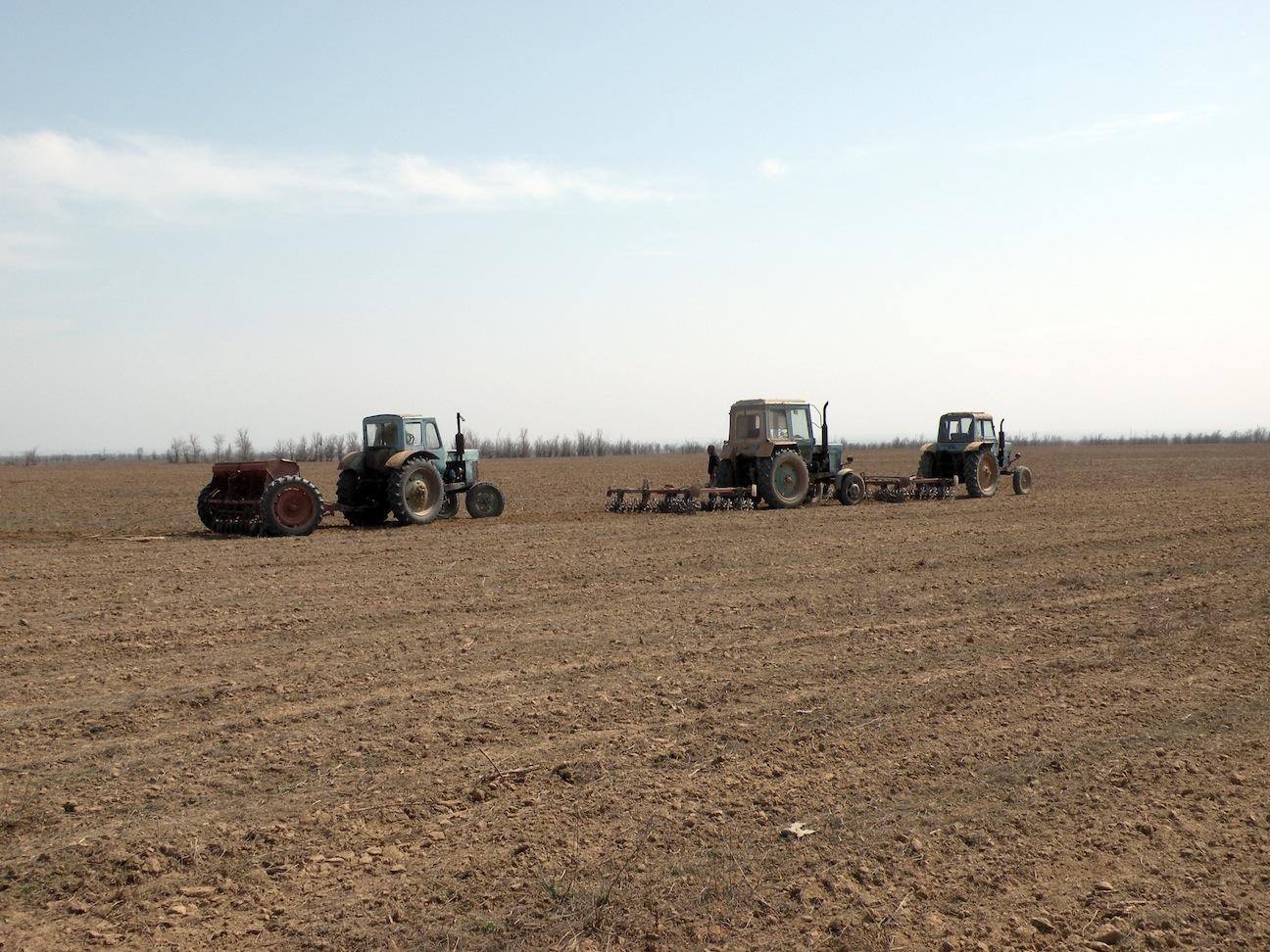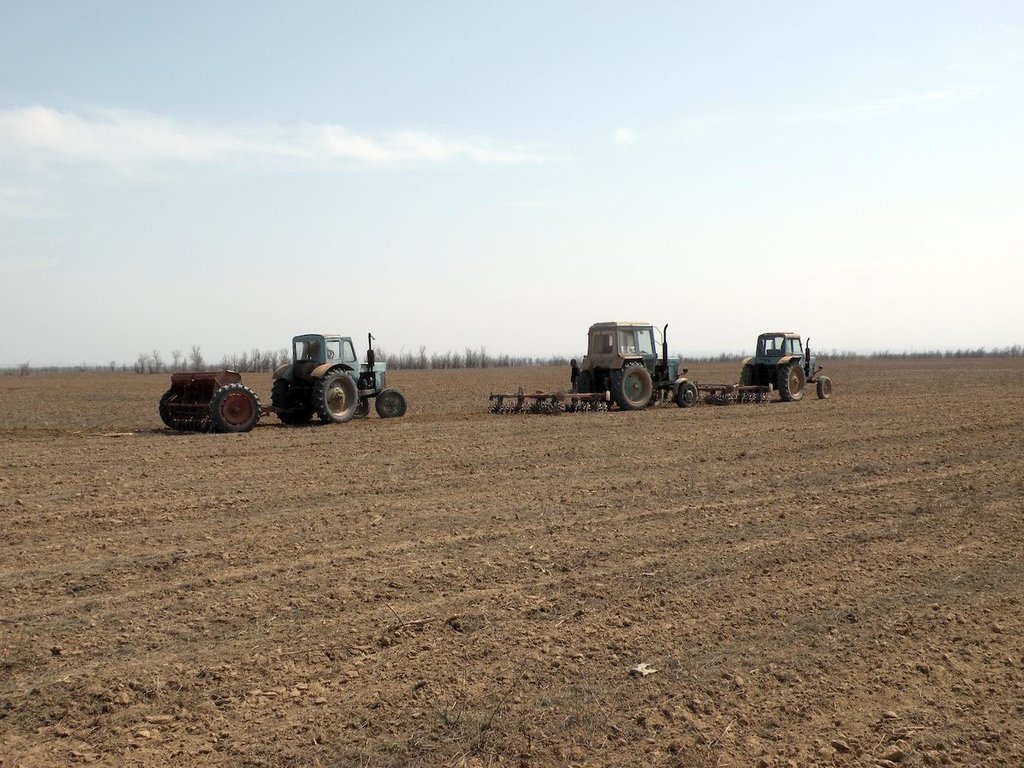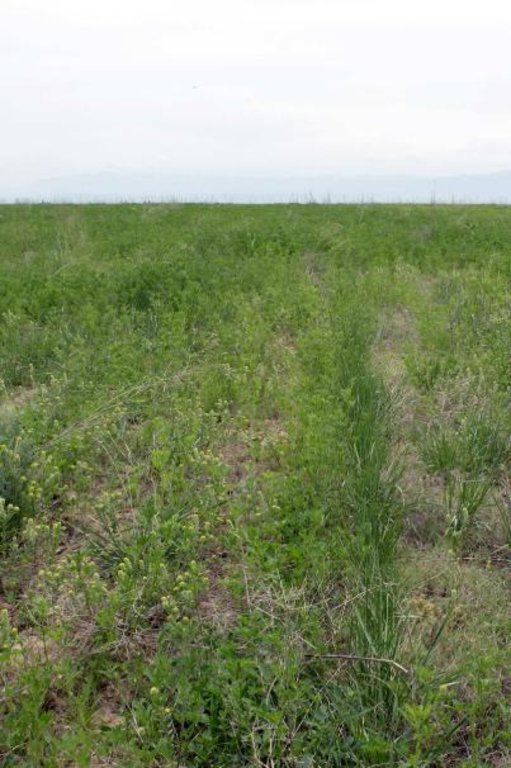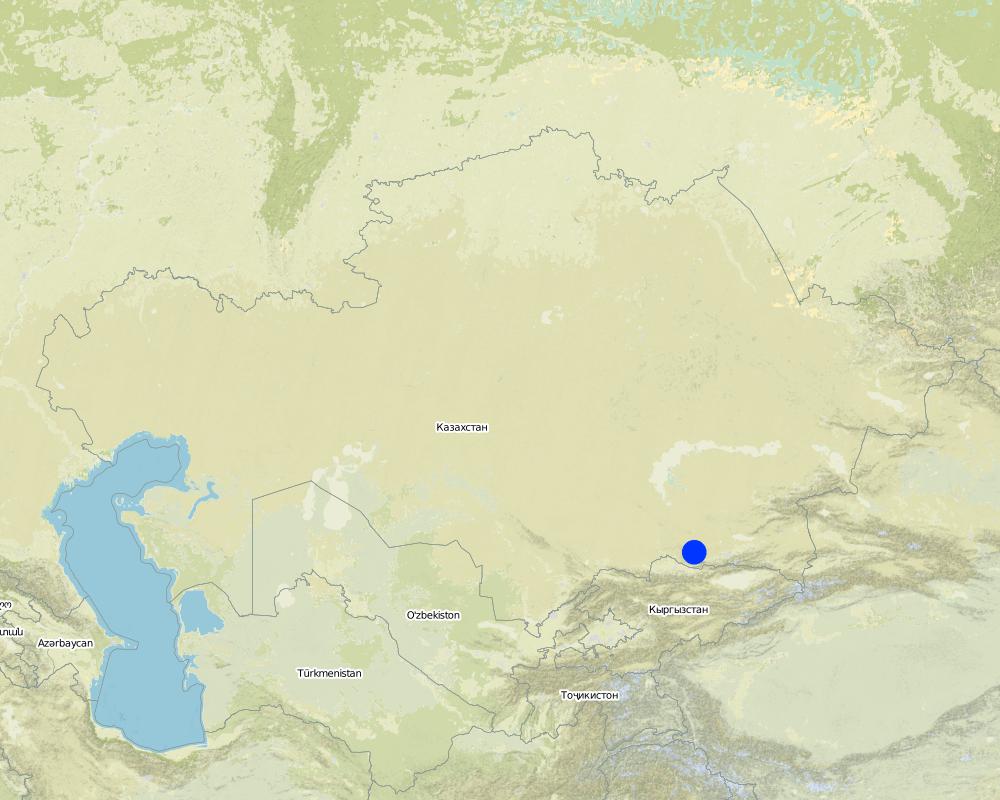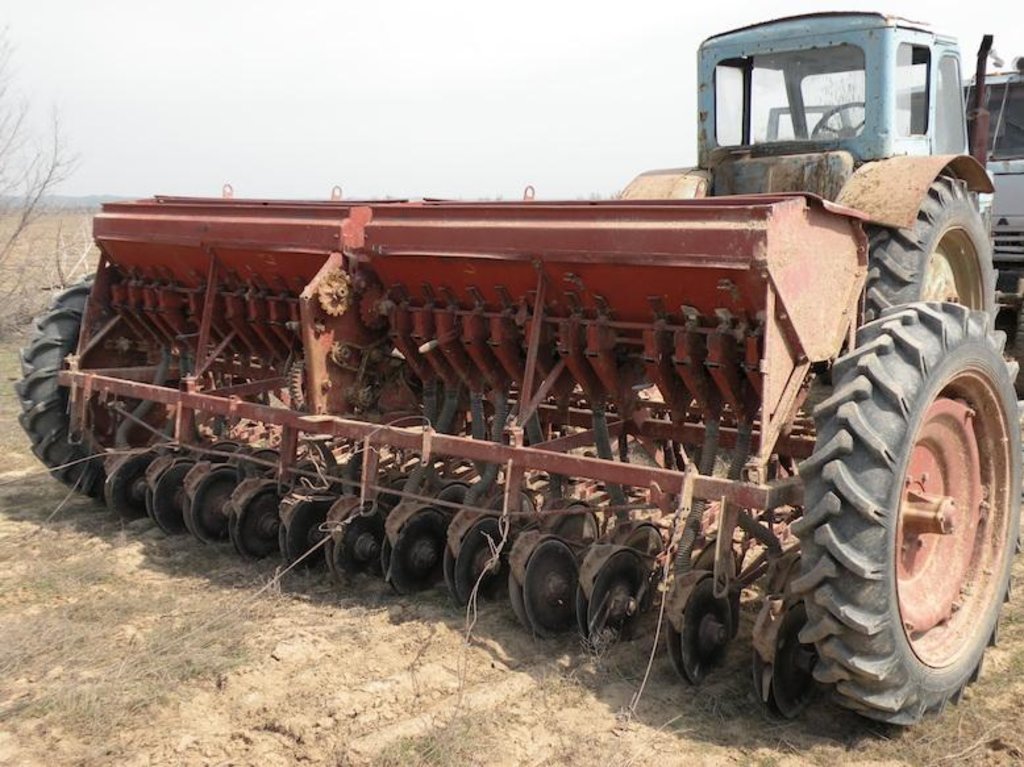Fallow restoration by no-tillage seeding [哈萨克斯坦]
- 创建:
- 更新:
- 编制者: Heino Hertel
- 编辑者: –
- 审查者: David Streiff, Alexandra Gavilano
Seeding of forage grass on fallow land
technologies_1175 - 哈萨克斯坦
查看章节
全部展开 全部收起1. 一般信息
1.2 参与该技术评估和文件编制的资源人员和机构的联系方式
SLM专业人员:
Sadyk Baktiyar
Zhasyl Azyk Fund
哈萨克斯坦
有助于对技术进行记录/评估的机构名称(如相关)
Deutsche Gesellschaft für Internationale Zusammenarbeit (GIZ) - 德国有助于对技术进行记录/评估的机构名称(如相关)
United Nations Development Program (United Nations Development Program) - 塔吉克斯坦1.3 关于使用通过WOCAT记录的数据的条件
编制者和关键资源人员接受有关使用通过WOCAT记录数据的条件。:
是
2. SLM技术的说明
2.1 技术简介
技术定义:
Fallow land restoration for fodder production is combined with biodiversity conservation of natural steppe vegetation by no-tillage disc-harrowing and seeding of forage grass in low density.
2.2 技术的详细说明
说明:
In March a plot of 380 ha twenty years abandoned wheat fields with stable perennial weed stadium, dominated by Artemisia lessingiana was cultivated by shallow disc-harrowing and seeding with A. cristatum. Agropyron cristata is a useful pasture grass, but it is invasive and tends to dominate an area for more than 15 years. For this reason, the seeding was done in half density then usual during Soviet time (10 kg/ha instead or more than 20 kg/ha) to avoid the strong dominance of the fodder grass and to maintain a balance between already established steppe vegetation and fodder grass. By disc-harrowing the dry inflorescens of Artemisia were destroyed and the dominance of this species diminished. This leads to a more species-balanced vegetation, which can provide fodder and hay and reduces the risk of locust mass development.
Purpose of the Technology: The fallow land in Kazakhstan comprises more than 10 million ha. With the climate change the agro-ecological zones will shift northwards, greatly reducing the area of the country in which cereals may be produced. As a result, more fields will be abandoned and the area of fallow land will further increase. After a few years, at most fallows a stable perennial weed stadium dominated by Artemisia lessingiana develops, which is not well eaten by livestock and promotes the mass development of locust.
Plowing and seeding with forage grass Agropyrum cristatum is the common method to minimize the risk of locust mass development and the production of fodder. But the seeding with A. cristatum has negative effects on soil structure and humus content and leads to a permanent vegetation strongly dominated by the forage grass and reduction of biodiversity.
With no-tillage cultivation and seeding in low density the biodiversity of steppe vegetation will remain and enriched with forage grass for utilization.
Establishment / maintenance activities and inputs: The cultivation was carried out in March 2010 by the farmer and his staff and his own machinery. The project provided the costs for seeds and fuel. After 1,5 years, in September 2011 the results were evaluated by botanists, project staff and the farmer. The field shows a balanced vegetation structure of natural steppe vegetation and sown forage grass with a moderate dominance of grass. The goal was fully achieved.
Natural / human environment: The technology of plowing and seeding with forage grass is well known by all local stakeholders, including the farmer. The adaptation to use no-tillage cultivation and half density of seeding was introduced by the project staff and is based on the results of an other project.
The farmer was ready to try the new technology on his farmland and provided land, machinery and staff. Other farmers, local and regional authorities, and the Ministry of Agriculture were interested in the results, which were published and used in other areas.
2.3 技术照片
2.5 已应用该技术的、本评估所涵盖的国家/地区/地点
国家:
哈萨克斯坦
区域/州/省:
Almaty Oblast
有关地点的进一步说明:
Zhambyl Rayon
具体说明该技术的分布:
- 均匀地分布在一个区域
如果技术均匀分布在一个区域,则指定覆盖的区域(单位为平方千米):
3.8
如果不知道精确的区域,请注明大致覆盖的区域:
- 1-10 平方千米
注释:
Total area covered by the SLM Technology is 3.8 km2.
Map
×2.6 实施日期
如果不知道确切的年份,请说明大概的日期:
- 不到10年前(最近)
2.7 技术介绍
详细说明该技术是如何引入的:
- 通过项目/外部干预
3. SLM技术的分类
3.1 该技术的主要目的
- 改良生产
- 保持/提高生物多样性
3.2 应用该技术的当前土地利用类型
同一土地单元内混合使用的土地::
是
具体说明混合土地使用(作物/放牧/树木):
- 农牧业(包括农牧结合)

农田
- 一年一作
年作 - 具体指明作物:
- 饲料作物 - 草
- 蔬菜 - 其他
- wheat
每年的生长季节数:
- 1
具体说明:
Longest growing period from month to month: March - November

牧场
粗放式放牧:
- 半游牧畜牧业
- 经营牧场
集约放牧/饲料生产:
- 改良牧场
注释:
Grass species: Agropyrum cristatum
Major land use problems (compiler’s opinion): At most fallow lands a stable perennial weed stadium dominated by Artemisia lessingiana develops, which is not well eaten by livestock, does not allow hay production and promotes the mass development of locust.
Major land use problems (land users’ perception): Fallow land is bad pasture, does not allow the production of hay and has the risk for mass development of locust. Thus, improvement of vegetation species composition of fallows for the use as pasture, fodder and hay production and minimizing the risk of locust mass development is very important.
Future (final) land use (after implementation of SLM Technology): Grazing land: Gi: Intensive grazing/ fodder production
Livestock density: 1-10 LU /km2
3.3 由于技术的实施,土地使用是否发生了变化?

牧场
- Extensive grazing
3.4 供水
该技术所应用土地的供水:
- 雨养
3.5 该技术所属的SLM组
- 畜牧业和牧场管理
- 最小的土壤扰动
3.6 包含该技术的可持续土地管理措施

植物措施
- V2:草和多年生草本植物

结构措施
- S5:大坝、集水斗、水池

管理措施
- M2:改变管理/强度级别
注释:
Secondary measures: management measures
Type of agronomic measures: rotations / fallows, zero tillage / no-till
Type of vegetative measures: aligned: -graded strips *<sup>3</sup>
3.7 该技术强调的主要土地退化类型

生物性退化
- Bs:质量和物种组成/多样性的下降
注释:
Main causes of degradation: crop management (annual, perennial, tree/shrub) (decades of wheat production and abandoned because of low production)
Secondary causes of degradation: change of seasonal rainfall, inputs and infrastructure: (roads, markets, distribution of water points, other, …), education, access to knowledge and support services
3.8 防止、减少或恢复土地退化
具体数量名该技术与土地退化有关的目标:
- 修复/恢复严重退化的土地
注释:
Secondary goals: prevention of land degradation, mitigation / reduction of land degradation
4. 技术规范、实施活动、投入和成本
4.1 该技术的技术图纸
技术规范(与技术图纸相关):
Grass seeding was done with normal drilling equipment but only 50% density of seeds.
Technical knowledge required for field staff / advisors: moderate
Technical knowledge required for land users: moderate
Main technical functions: promotion of vegetation species and varieties (quality, eg palatable fodder)
Secondary technical functions: increase in organic matter, increase of biomass (quantity)
Aligned: -graded strips
Vegetative material: G : grass
Grass species: Agropyrum cristatum
Change of land use practices / intensity level: extensive used fallow was converted into forage production land and intensive grazing land
4.2 有关投入和成本计算的一般信息
具体说明成本计算所用货币:
- 美元
4.3 技术建立活动
| 活动 | 时间(季度) | |
|---|---|---|
| 1. | disc-harrowing, seeding | March |
| 2. | Purchase of seeds | |
| 3. | Delivery of seeds | |
| 4. | Repairing machinery, work |
4.4 技术建立所需要的费用和投入
| 对投入进行具体说明 | 单位 | 数量 | 单位成本 | 每项投入的总成本 | 土地使用者承担的成本% | |
|---|---|---|---|---|---|---|
| 劳动力 | Repairing machinery, work | ha | 1.0 | 2546.0 | 2546.0 | 100.0 |
| 设备 | Machine use | ha | 1.0 | 6311.0 | 6311.0 | 3.0 |
| 植物材料 | Purchase of seeds | tons | 4.5 | 3733.3333 | 16800.0 | |
| 植物材料 | Seeds | kg | 10.0 | 6.8 | 68.0 | 11.0 |
| 其它 | Delivery of seeds | all seeds | 1.0 | 200.0 | 200.0 | 100.0 |
| 其它 | Diesel Fuel | for delivery | 1.0 | 3.0 | 3.0 | 3.0 |
| 技术建立所需总成本 | 25928.0 | |||||
| 技术建立总成本,美元 | 25928.0 | |||||
注释:
Duration of establishment phase: 1 month(s)
4.6 维护/经常性活动所需要的费用和投入(每年)
注释:
Costs are calculated per hectare.
4.7 影响成本的最重要因素
描述影响成本的最决定性因素:
purchase of seeds
5. 自然和人文环境
5.1 气候
年降雨量
- < 250毫米
- 251-500毫米
- 501-750毫米
- 751-1,000毫米
- 1,001-1,500毫米
- 1,501-2,000毫米
- 2,001-3,000毫米
- 3,001-4,000毫米
- > 4,000毫米
农业气候带
- 半干旱
Thermal climate class: temperate
5.2 地形
平均坡度:
- 水平(0-2%)
- 缓降(3-5%)
- 平缓(6-10%)
- 滚坡(11-15%)
- 崎岖(16-30%)
- 陡峭(31-60%)
- 非常陡峭(>60%)
地形:
- 高原/平原
- 山脊
- 山坡
- 山地斜坡
- 麓坡
- 谷底
垂直分布带:
- 0-100 m a.s.l.
- 101-500 m a.s.l.
- 501-1,000 m a.s.l.
- 1,001-1,500 m a.s.l.
- 1,501-2,000 m a.s.l.
- 2,001-2,500 m a.s.l.
- 2,501-3,000 m a.s.l.
- 3,001-4,000 m a.s.l.
- > 4,000 m a.s.l.
5.3 土壤
平均土层深度:
- 非常浅(0-20厘米)
- 浅(21-50厘米)
- 中等深度(51-80厘米)
- 深(81-120厘米)
- 非常深(> 120厘米)
土壤质地(表土):
- 中粒(壤土、粉土)
表土有机质:
- 中(1-3%)
如有可能,附上完整的土壤描述或具体说明可用的信息,例如土壤类型、土壤酸碱度、阳离子交换能力、氮、盐度等。:
Soil fertility is medium
Soil drainage / infiltration is medium
Soil water storage capacity is medium
5.4 水资源可用性和质量
地下水位表:
5-50米
地表水的可用性:
匮乏/没有
水质(未处理):
不良饮用水(需要处理)
5.5 生物多样性
物种多样性:
- 中等
5.6 应用该技术的土地使用者的特征
生产系统的市场定位:
- 混合(生计/商业)
非农收入:
- 低于全部收入的10%
相对财富水平:
- 平均水平
个人或集体:
- 个人/家庭
机械化水平:
- 机械化/电动
性别:
- 女人
- 男人
说明土地使用者的其他有关特征:
Land users applying the Technology are mainly common / average land users
Population density: < 10 persons/km2
Annual population growth: 2% - 3%
5.7 应用该技术的土地使用者使用的平均土地面积
- < 0.5 公顷
- 0.5-1 公顷
- 1-2 公顷
- 2-5公顷
- 5-15公顷
- 15-50公顷
- 50-100公顷
- 100-500公顷
- 500-1,000公顷
- 1,000-10,000公顷
- > 10,000公顷
这被认为是小规模、中规模还是大规模的(参照当地实际情况)?:
- 中等规模的
5.8 土地所有权、土地使用权和水使用权
土地所有权:
- 州
- 公司
土地使用权:
- 社区(有组织)
- 租赁
5.9 进入服务和基础设施的通道
健康:
- 贫瘠
- 适度的
- 好
教育:
- 贫瘠
- 适度的
- 好
技术援助:
- 贫瘠
- 适度的
- 好
就业(例如非农):
- 贫瘠
- 适度的
- 好
市场:
- 贫瘠
- 适度的
- 好
能源:
- 贫瘠
- 适度的
- 好
道路和交通:
- 贫瘠
- 适度的
- 好
饮用水和卫生设施:
- 贫瘠
- 适度的
- 好
金融服务:
- 贫瘠
- 适度的
- 好
6. 影响和结论性说明
6.1 该技术的现场影响
社会经济效应
生产
饲料生产
饲料质量
畜牧生产
生产故障风险
收入和成本
农业收入
社会文化影响
食品安全/自给自足
SLM/土地退化知识
livelihood and human well-being
生态影响
土壤
土壤有机物/地下C
生物多样性:植被、动物
生物量/地上C
植物多样性
有益物种
害虫/疾病控制
减少气候和灾害风险
火灾风险
6.3 技术对渐变气候以及与气候相关的极端情况/灾害的暴露和敏感性(土地使用者认为的极端情况/灾害)
渐变气候
渐变气候
| 季节 | 增加或减少 | 该技术是如何应对的? | |
|---|---|---|---|
| 年温度 | 增加 | 好 |
气候有关的极端情况(灾害)
气象灾害
| 该技术是如何应对的? | |
|---|---|
| 局地暴雨 | 未知 |
| 局地风暴 | 好 |
气候灾害
| 该技术是如何应对的? | |
|---|---|
| 干旱 | 好 |
水文灾害
| 该技术是如何应对的? | |
|---|---|
| 比较和缓的(河道)洪水 | 未知 |
其他气候相关的后果
其他气候相关的后果
| 该技术是如何应对的? | |
|---|---|
| 缩短生长期 | 好 |
6.4 成本效益分析
技术收益与技术建立成本相比如何(从土地使用者的角度看)?
短期回报:
稍微积极
长期回报:
非常积极
技术收益与技术维护成本/经常性成本相比如何(从土地使用者的角度看)?
短期回报:
非常积极
长期回报:
非常积极
6.5 技术采用
- 单例/实验
在所有采用这项技术的人当中,有多少人是自发的,即未获得任何物质奖励/付款?:
- 0-10%
注释:
100% of land user families have adopted the Technology with external material support
There is no trend towards spontaneous adoption of the Technology
Comments on adoption trend: Technology was adopted by Ministry of Agriculture and is widely used in variations throughout the country.
6.7 该技术的优点/长处/机会
| 土地使用者眼中的长处/优势/机会 |
|---|
|
Good pasture quality and fodder production How can they be sustained / enhanced? Monitoring of pasture quality and fodder production over the next years |
|
Prevention of locust mass development How can they be sustained / enhanced? Observation of locust development at sample plot |
| 编制者或其他关键资源人员认为的长处/优势/机会 |
|---|
|
Good compromise between production of fodder and conservation of natural steppe vegetation How can they be sustained / enhanced? Monitoring of species composition and growth rate over the next years to prove ecological stability |
6.8 技术的弱点/缺点/风险及其克服方法
| 土地使用者认为的弱点/缺点/风险 | 如何克服它们? |
|---|---|
| Using old technology (plowing and seeding with full density) would create a monoculture of grass which is more useful as fodder then a mixed vegetation | The seeding density could be increased while no-tillage cultivation is used |
| 编制者或其他关键资源人员认为的弱点/缺点/风险 | 如何克服它们? |
|---|---|
| There is only little influence on the species composition | Controlled burning of dry Artemisia inflorescens before disc-harrowing would promote grass species and avoid Artemisia dominance. |
7. 参考和链接
7.1 信息的方法/来源
7.2 参考可用出版物
标题、作者、年份、ISBN:
„Kazakh Model for Sustainable Pasture Use“, Almaty 2011, Sadyk et al.
可以从哪里获得?成本如何?
UNDP Kazakhstan, Ministry of Agriculture Kzakhstan
链接和模块
全部展开 全部收起链接
无链接
模块
无模块


